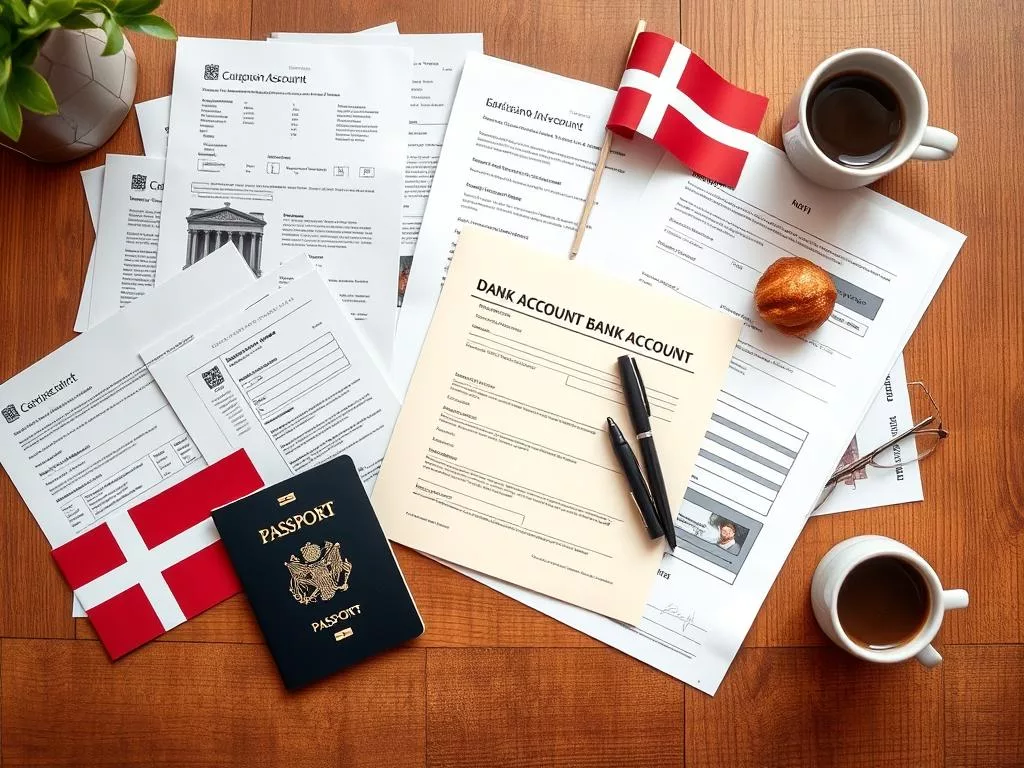Understanding the Danish banking system as a non-resident is key. You need to know about the NemKonto system and getting a Danish Civil Registration number (CPR number). The NemKonto is a must for getting payments like tax refunds and child subsidies from Danish authorities.
To open a bank account in Denmark, you need important documents and to follow certain steps. Getting a CPR number in Denmark is vital for your NemKonto. This can be a local or foreign bank account, with no fees.
Danish banking rules let public authorities safely deposit funds into your NemKonto. But, they can’t withdraw or see your account details, keeping your info private.
Non-residents should know that getting a NemKonto often means visiting a local bank in Denmark or using an online platform with a MitID. It’s important to understand the details of local banking and Danish procedures. This is even more true when dealing with the challenges of living abroad and Danish bureaucracy.
Requirements for Opening a Bank Account as a Non-Resident
Opening a bank account in Denmark as a non-resident needs careful planning and specific documents. You must show your ID, like a passport or driving license. You also need your employment contract and sometimes a tax card.
A key document is your Civil Registration (CPR) Number. It shows you legally live in Denmark and is needed for many financial tasks.
Danish banks follow strict rules to identify you. Non-residents must provide detailed documents to fight money laundering and know who you are. This includes proof of where you live, your ID, and business details for business accounts.

Setting up an account often requires being in Denmark. While online banking is common, a visit is often needed for checks. Getting a NemID, a secure digital ID, is important for online banking and government services.
The table below shows the cost of living in Denmark. This helps understand the financial needs of managing an account:
| Expense | Cost (DKK) |
|---|---|
| Rent | 3,000-5,000 |
| Insurance | 200 |
| TV License | 100 |
| Books and Supplies | 250-500 |
| Mobile Phone | 150 |
| Internet | 250 |
| Food | 1,500-2,000 |
| Transport | 300 |
| Other Personal Expenses | 1,000 |
Traditional banks like Danske Bank have strict rules. But, Electronic Money Institutions (EMIs) like Payset are easier for non-residents. EMIs support Danish Krone, US Dollar, and Euro transactions. They offer good exchange rates and lower fees.
Choosing between traditional banks and EMIs depends on your needs. EMIs like Payset are great for quick online setups. They’re good for UK businesses in Denmark. But, always check all requirements and banking rules in Denmark.
Step-By-Step Guide to Open Bank Account in Denmark as Non Resident
For non-residents, figuring out how to open a Danish bank account is key. First, get a CPR number, a unique ID for all residents. Without it, starting any financial process, like opening a bank account online, is impossible.
After getting your CPR number, you need a NemID. This ID is like a digital signature for online banking. You’ll need to show your yellow health card, proof of residence, and ID when applying.

Having a NemKonto is essential for receiving payments from Danish public institutions. You can set one up online with a NemID. Here’s how to do it:
- Register for a CPR number.
- Get a NemID for secure online access.
- Submit your ID documents to your bank.
- Choose a NemKonto for easy payments.
After these steps, you can use online banking and get a Dankort for daily purchases. But, opening an account online is hard without these basics. Also, be aware of fees, as Danish banks charge for services. Knowing each step well makes banking in Denmark easier.
The Danish banking system has its challenges but also benefits. You can diversify your wealth and access many currencies. Most branches are open from 10:00 to 16:00, with an extra hour on Thursdays. Plus, staff often speak English, helping non-residents.
Challenges and Considerations for Non-Residents
Opening a bank account in Denmark as a non-resident comes with many challenges. You need to provide detailed documents like proof of identity and address. Also, you might need to show your residency status. Many banks ask non-residents to visit in person, which is not the case for residents who can apply online easily.
The cost of living in Denmark is high, making money management tough for non-residents. For example, a one-bedroom apartment’s average rent is around 7,000 DKK per month. This adds to the financial stress.
The Danish banking system has faced scandals, like the Danske Bank money-laundering case. This has led to stricter rules. Non-residents face more regulations and oversight, making banking harder. They have to choose from over 4,880 banks in the European Union, often needing to visit in person.
Some non-residents might prefer alternative financial services. Wise, for example, offers a simple way to manage money in over 50 currencies. It provides local banking details for receiving payments without extra fees. Services like Wise are easier to use than traditional banks.
Non-residents must decide between the security of Danish banks and the convenience of digital services. For more tips on managing money abroad, check out common pitfalls with debit cards.

